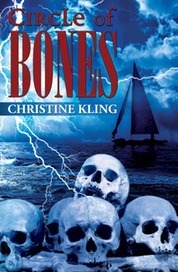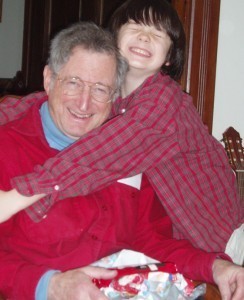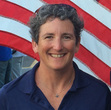Carol Newman Cronin's Blog, page 57
February 8, 2013
Mother vs. Mother Nature
Some days (especially in February), forces of the universe oppose each other. Today, Mother Nature is winning over Mother.
We were supposed to drive to the Cape today, to celebrate Mom’s birthday. Now if truth be told her actual birthday was yesterday. But she’s reached a stage in life where she gets to choose which day to actually celebrate, and she’d chosen today.
Unfortunately, that’s also the day when a large Nor’easter has chosen to swoop up the eastern seaboard. It’s already snowing here on the shores of Narragansett Bay, and there’s enough white stuff blowing around that it’s hard to see the harbor and the driveway has already disappeared. For those friends in San Diego, North Carolina, and Florida who like to gloat about this sort of thing, it’s supposed to turn to rain and then back to snow again here. We might even get some ice (not in cubes, but in drizzly needles).
The storm is named (somewhat incongruously) Nemo. I’m still getting used to named storms that involve snow; to me a “named storm” is a hurricane. And Nemo is a whale, not a storm.
I’m also having to adjust, once again, to the idea that Mother Nature can still get in the way of our plans.
We’re in very good shape, really. This was an elective trip, easy to cancel, involving only a bit of disappointment all around and a quick call to a florist who managed to deliver a bouquet quite promptly. It will be a lot harder for those (commuters, and those folks who are trying to get home in the next few days) who can’t just choose not to go.
Working from home is great, but today I’m especially appreciative: shoveling when we choose instead of on a tight deadline, perhaps a break to walk in the snow at lunchtime. But I will be thinking of Mom today, and wondering when the roads will be clear enough for a belated birthday visit.
It’s a good thing Mother taught me to like Mother Nature, even when she interferes with our plans.
January 30, 2013
Where Books Don’t Meet Boats: Athletic Determination
Greetings from my offsite “office” in Coconut Grove, Florida. I escaped the icy north last week and have managed to cobble together a Cronin family get together, work, Olympic “research”, a little more work, and a Snipe regatta this weekend.

The new Nacra 17 is unique to the Olympic family in two ways: it’s coed, and it’s a catamaran (two hulls). Photo: Walter Cooper/US Sailing
Yesterday I was able to sneak out on the water for a few hours to watch some of the sailors racing in Sailing World Cup Miami, the biggest event on the US calendar for Olympic hopefuls. The odds are pretty dang good that all the 2016 medal winners are sailing here this week, so it was a great chance to see two new classes (the coed Nacra 17 catamaran and the women’s 49er FX skiff) in action.
The classes may be new, but the determination and dedication of the athletes were all too familiar. Most of them are full-time, fully devoted to their Olympic goals in a way that most life choices don’t demand. They must go out every day and push themselves, analyzing weaknesses all the way through the event and trying to minimize or eliminate mistakes wherever possible. Salt, rinse, repeat. It’s inspiring to watch, exhausting to go through, and the main reason the Olympics still hold so much appeal for so many of us.
Last night, with the inspiring taste of salt spray and sheer determination still in my mouth, I settled in as usual to read a novel. This week’s choice is by a well-known author, and I’d read and enjoyed several of her previous books. But her latest isn’t cutting it.
And the reason, I realized, is the editing, which seemed fine early on but has not kept up into the middle pages. Parts of the book read like a first draft, a stream of consciousness “must communicate this background information” that interferes with my enjoyment of the story. And while there are no actual typos or mistakes, the language doesn’t sing the way it would with a little more fine tuning.
Is it possible that unlike our Olympic athletes, editors of well-known authors are no longer pushing themselves to do the best job they can?
The copy I’m reading happens to be an e-book. Unlike a paperback, where I can (and usually do) flip to a middle chapter when book shopping, it’s easy for the editors to know where the free sample will end. Since the change was so drastically obvious in this case, I’m guessing there was a lot more editing time put into the first twenty percent than into the rest of this particular book.
Like Olympic training, editing takes time. It’s not always easy to see progress, and it can be hard to know when the work is finished. In this book’s case (and several others I’ve read recently), our time-pressured world seems to be prioritizing quantity over quality. And it worked, since I bought the book. Based on the free sample, backed up by the name of a well-known author whose work I’d enjoyed before, I figured it would be an enjoyable read. I didn’t expect to find myself thinking more about the editing than the story.
Maybe I should send the editor an invitation to get out on the water and see our athletes at work. That would be the perfect reminder of what dedication all the way to the end looks like.
For results, updates, and many more photos, visit the Sailing World Cup Miami site.
January 23, 2013
Mid-life Passion
A recent Rod Davis article in Seahorse Magazine got me thinking: why is it that from the outside, mid-life passion looks like mid-life crisis?
Rod recently bought an OK dinghy to get back to having fun on the water. As one of the top coaches in sailing, he spends most of his time watching other people sail. In a blog post on Sail-World, he said it was time “to sail and race for myself, you know, just because it’s a super fun thing to do.”

OK Dinghy Victoria State Championship 2011
That sounds pretty normal to me, and it’s why I sail a Snipe. There’s little glory and nothing riding on our finishes: no funding, no pay upgrades or sponsorship deals. Just the simple pleasure of getting out on the water, competing with friends, and trying not to make the same mistakes over and over again.
Normal, maybe… and yet so rare. By the time we get to middle age, most of us have taken on so many responsibilities it’s hard to carve out any time for ourselves. And in our increasingly professional world, hobbies and passion are downplayed as a distraction, poo-pooed as lacking focus and grace and professionalism. Why would we devote so much time and effort to something that doesn’t bring any obvious benefit?
It may not be obvious, but the main benefit is psychological. Passion gets us out of bed in the morning, usually before the alarm. It balances our lives against an all-work-no-play mentality that usually burns out out. Physically, it keeps me working out, since dinghy sailing is a lot more fun when you’re in shape. And unlike many other pleasures (red wine, coffee, dessert) there’s no disagreement about the long-term benefits of fitness.
I have an Albert Einstein quote under my desk blotter that I pull out every so often: “We act as though comfort and luxury were the chief requirements of life, when all we need to make us happy is something to be enthusiastic about.” Einstein was wise about more than just science.
In my eight years on the US Olympic Committee’s Athlete Advisory Council, I met athletes who were finished with their sport at age 25. They must have wondered how someone with so many gray hairs managed to hobble onto the Olympic stage recently enough to still be eligible as an athlete rep, but their stories made me feel lucky. My sport is a lifelong sport. The only challenge is finding a fleet that matches our goals as they change throughout our lives.
I’ve found a family of similiarly committed middle-aged sailors in the Snipe. It sounds like the OK dinghy is a good match for Rod’s fun meter. And I know plenty of others who sail the Laser locally, nationally, or internationally, combining challenges both physical and mental with the friends who understand why that’s so rewarding.
On the long drive to Florida to begin my winter season of racing, I’ll remember Rod’s closing thought: “ “I think we should save at least part of our lives to go with passion and enjoy the sport we all love… grass-roots style.”
This might be mid-life, but it ain’t no crisis.
Photo courtesy OK Dinghy class association
January 16, 2013
Winter: Canvas of Gray
After the riot of summer flowers and fall leaves, winter often stretches colorless through the doldrums of January and February. Fresh snow sparkling in sunshine might brighten the neighborhood occasionally, at least until the plows come through. But a more typical Rhode Island winter day dawns gray and seems to fade away the same way, only a few hours later.
Yesterday I was reminded that this gray is just a canvas, a backdrop for the beauty all around us. This time of year we learn to make the most of any warm days, so when the temperature climbed to a balmy 55, I dragged myself away from my desk and outside at midday. Walking by the harbor, I realized the complete lack of wind had turned it into an unexpected mirror. The water I knew so well now shimmered in pink, blue, even gold, reflecting thin clouds I hadn’t even noticed overhead. Seen from above, it was a real-life watercolor. I slowed my steps, watching as long as I could; New England winter colors don’t stick around long.

Winter water reflects any hint of color in this rusty fishing skiff. Photo courtesy PaulCroninStudios.com
Except in sunsets. A few hours after my walk, long, streaks of gold clouds ripened to red, then pulsed purple, and finally darkened into dusk. I could have spent an hour watching the colors change; instead I glanced west every five or ten minutes, wondering how change could be so unseen and yet so obvious once it happened.
Kind of like the seasons themselves.
For even as we settle into the depth of winter, dreading the next deep freeze and blessing our beefy furnaces, the light is changing. Damp gray dark mornings happen sooner than a month ago. And those rich lengthy sunsets stretch colorful fingers into the sky well beyond quitting time. The earth is not sleeping but turning slowly on its axis toward spring, giving us the winter-precious chance to sleep late, to maybe waste a few hours on an inside project that will go nowhere, to read for hours on the windowseat, to savour the gift of time. A season for learning to see subtle variations in our surroundings, the quiet changes we we miss in the milder months when we’re distracted by a sudden flash of in-your-face green or yellow or red.
It’s a beautiful gray, if you know where to look.
Photo copyright ©Paul Cronin Studios, from The World Around Us photo gallery
December 27, 2012
Holiday Book List #2: For Sailors
I was recently asked to write a Holiday Book list for SnipeToday, and it was so much fun I wanted to share the books I chose with all of you. I’ve removed two titles that already appeared on my previous 2012 Holiday Book List. Enjoy!
As an author and sailor, I tend to prefer books about the sea. Better yet, novels about dinghy sailing… but those are very few and far between*. Here are some sailing-related works of fiction you might enjoy, just in time for those of us in the northern hemisphere to enjoy during the winter reading season.
Circle of Bones: a Caribbean Thriller (Christine Kling)
This is a book to sink your teeth into, especially for sailors: a classic crime thriller set in large part in the Caribbean on a sailboat. The author is one of the founding members of WriteontheWater.com and lives part time on her cruising sailboat, so the salty language rings true. Visit Christine’s website for more info.
By Force of Arms (James L. Nelson)
This first of a five novel series is set just before the American Revolution, based on and around Narragansett Bay. Narrated by a captain loosely based on John Paul Jones, the excellent sailing detail reflects author Jim Nelson’s time on replica warship The Rose. Jim has also written two other fictional series, The Brethren of the Coast Trilogy (about pirates) and the award-winning Samuel Bowater Books (three novels about a young Confederate ship captain during the American Civil War). All are highly recommended. For more info, visit Jim Nelson’s website.
The Wind and the Willows (Kenneth Grahame)
This is an old childhood classic, the story of Water Rat introducing his new friend Mole to life on the River. “Believe me my young friend, there is nothing—absolutely nothing—half so much worth doing as simply messing about in boats.” Originally published in 1908, the language is a bit dated… but the story still pleases my modern nieces and nephews. Read it or reread it! It’s still in print, available at your local bookseller or online.
*And last but not least…
I can’t help mentioning the only novel that I know of about dinghy racing, even though I happen to be the author. Game of Sails is an Olympic love story about two opposites who team up to make it to the Games, in a doublehanded boat that is what a Snipe would be if it had a trapeze and assymetrical spinnaker. One reviewer said, “If you like sailing, romance and some revenge, you will like this book.”
Best wishes for the holidays, and I hope to see you on the water in 2013!
December 14, 2012
2012 Holiday Book List
It’s that time again… wrapping paper, bows, wreaths, and book recommendations!
This year I feel privileged to know all but one of the authors I’m recommending; hopefully you will see that as a plus, rather than a biasing minus. Either way—enjoy.

The joy of giving, and receiving… my Dad and nephew Sam, Christmas 2009.
1. Uncharted (Bridget Chicoine)
This lovely debut novel tops my list this year because I could recommend it to anyone: salty sailors, armchair writers, lovestruck teens. Bridget Chicoine has become a friend, and one of my goals for 2013 is to meet her face to face now that she’s relocated to New England.
Book Review: Uncharted is off the Charts
2. The Fulcrum Files (Mark Chisnell)
Here’s another book I could recommend to anyone I know, especially those who enjoy thrillers. This is Mark’s first (and hopefully not his last) historical novel, and though it revolves around boats he likes to remind me that there is actually no sailing in it. Originally published as an ebook, it’s now available as a paperback.
You may remember a previous recommendation for Mark’s excellent account of the round the world Volvo Race, Spanish Castle to White Night.
Full Review
3. The Unfinished Work of Elizabeth D. (Nichole Bernier)
This debut novel was a long-awaited addition to my nightstand, and I gobbled it up in less than 24 hours. This one is the perfect read for anyone wondering what happens after happily ever after.
Full Review
4. The Bracelet (Roberta Gately)
Roberta is one of my best writing/author friends, and her second book is even better than her debut, Lipstick in Afghanistan. An ER nurse in her “real” life, Roberta has taken some of her experiences in Afghanistan and turned them into two novels that bring the news stories much closer to home. It’s been several months since I finished The Bracelet, and I can still taste the dust.
Full Review
5. The Shortest Way Home (Juliette Fay)
This is Juliette’s third novel, and she has somehow managed to create all-new characters and an entirely new story and set it in the same town and world as her first book. This not-quite-sequel is a great combination of familiarity and freshness.
Full review: The Shortest Way to Family
6. Little Boy Blue (Kim Kavin)
I work with Kim in my “real” job, editing the stories she sends in from the world of crewed yacht charters. In this book, Kim uses her reporting skills to dig deep into a very different topic: the world of dog shelters and online adoptions. It was one of my only non-fiction reads in 2012.
Full Review
7. Whitethorn Woods (Maeve Binchy)
This book got under my skin, but in hindsight I read it surrounded by the beauty of its terrain—small waterside towns in central Ireland. Since I discovered this in a used bookstore in Carrick-on-Shannon, I’ve devoured another 5-6 Maeve Binchy books. I’ve also realized that their marketing and cover art here in the US kept me from picking them up in the past.
Sadly, Maeve Binchy died last July, but her final novel, A Week in Winter, will be published here in the US next spring.
Maeve Binchy’s website
On my reading list for next year:
The Comfort of Lies by Randy Susan Meyers (February 2013)
Clover House by Henriette Lazaridis Power (April 2013)
Wondering where to buy your books? My local bookstore, Island Books, opened a new location on Spring Street in Newport just before Labor Day. The staff is always helpful and it’s easy to lose yourself in browsing, so if you’re in the area, stop by.
Enjoy this festive season, and support your local bookseller!
November 29, 2012
The Psyche of Self-Employment
Yesterday I filled out the annual paperwork update at my doctor’s office. Name, address, phone number… the information has been so mind-numbingly consistent the last fifteen years, it seems silly they still bother to ask.
And then I got to the next line, where it says “Employer.”
A few days from now, I will officially join the ranks of the employed. So I hesitated: should I write in “Self” one more time, or change my status before it was quite honest to do so?
After two decades of working for myself, going to work for someone else is a pretty big adjustment—at least psychologically. Since that someone else is my favorite client, Boats.com, my actual work life won’t be changing that much.
But that doesn’t make it a simple transition when it comes to the little stuff, like doctor’s forms or questions from strangers. “I work for myself” always results in an eyebrows-raised smile, and usually there’s a follow up question: “Oh, what do you do then?”
Even though I’ll be answering the same thing to the second question, I’m going to have to wean myself away from the confidence-boost of self-declared self-supportingness, as well as its underlying unsaid companion: “Don’t you wish you could do that too?”
Here are some other things that will be different as a result of becoming employed:
1. The postman may notice that I’m not always asking, “Any checks?” when he shows up each afternoon.
2. I won’t be trolling for potential clients at parties.
3. I will have to plan a vacation each year.
The list of things that will NOT be different is longer:
1. I’ll continue to work at home.
2. I’ll continue to do something different almost every day.
3. I’ll continue to work with a great group of editors and writers.
4. I’ll continue to go to regattas.
5. I’ll continue to take care of a handpicked array of existing clients, though now it will be “on the side.”
6. I’ll continue to have days that are very productive, and those other days too.
7. My desk will still be messy.
And hopefully I’ll continue to publish this blog, because it clears my head to write out thoughts without once considering SEO or marketing plans.
So the biggest adjustment by far will be psychological. For the past twenty years, self-employment has been a big part of my self-identity.
But the next time I’m filling out a form at the doctor’s office, I’m going to have to write a company name next to ”Employer.” Which doesn’t seem like it should be so hard.
Especially since I have another 364 days to get used to the idea.
November 23, 2012
The Shortest Way to Family: A Book Review
I come from a very traditional nuclear family: stay at home Mom, go to work Dad, two siblings from (gasp) the same biological parents. But I also belong to less traditional family units, like my family of Snipe. Sailors who come together with a specific purpose, year after year, celebrate a bond that is (mostly) unrelated to blood or geography, proof that family can grow anywhere there is a common need or focus.
Which is part of why I found Juliette Fay’s latest book, The Shortest Way Home, so fascinating. I’d really enjoyed Fay’s previous two books, partly because they take place in a fictional version of the town where I earned my high school diploma. But this latest book is the best so far, because it stretches the bounds and definitions of family.
The main character, Sean Dorgan, is in equal parts lovable and completely frustrating. After years of running away from his own family to take care of strangers, he returns home to discover a dysfunctional group greatly in need of nursing—his chosen specialty. Fay does a great job of stringing us all along; readers know what Sean really wants, so every time he turns away from it we throw up our hands at his choices. Tempering the frustration is the realization that Sean has become very real to us, like a guy we went to high school with who recently appeared again around town.
I enjoyed the first few chapters of the book for its own sake; Fay’s language and storytelling are both straightforward and clear without being at all dull. So the re-introduction of a main character from her previous book, Shelter Me, was an unexpected bonus. Again, it was like catching a glimpse of a person I used to know well but had lost track of. And seeing Janey from a bit of distance, instead of through the intense proximity of her narrator eyes, proved that “happily ever after” is in the eyes of the beholder.
As Sean begins to discover the meaning of family, he draws us into his world. We relate to the oddities in people and occurrences around him and appreciate his good intentions, even if the results aren’t always perfect. And though at times things seemed a little too easy for him (a job and a trip both drop into his lap that fit his short-term needs perfectly), he has plenty of struggles to show us his true personality.
My favorite scene involves a clashing of two realities: the local school nurse’s office meets real world problem-solving. I won’t tell you anymore than that, but I will tell you to read this book or give it to your favorite reader. Warm yet real, engaging yet at times annoying, Fay’s characters are yet another form of family that I’ve added to my collection. I can’t wait for their next adventure.
For more information, visit Juliette Fay‘s website.
November 15, 2012
It’s All About the Team: Boat Reviews in the Video Age
Anyone keeping track of this blog might have noticed the absence of a post last week. That’s because I was in Florida… not sailing in Miami as you might expect, but working in what the locals call “the Palm Beaches.” Although no lifejacket was required, sunscreen was applied—a nice change of pace from November in a New England office.

Lenny Rudow (with sunglasses) and Paul Cronin take a break from using their respective reviewing tools: pad and video camera.
Boats.com sent me (along with videographer/husband Paul) south to produce video boat reviews of seven Cruisers Yachts powerboats that ranged in size from 23-48 feet. For those of you that have never heard of Cruisers, neither had I. But the Wisconsin company will celebrate their sixtieth anniversary next year, an amazing show of longevity in the boatbuilding industry.
Now you all know I’m not really into powerboats… and yet by day four, I’d developed a lot of respect for the quality and attention to detail that Cruisers puts into its products. When reviewer (and fellow editorial staff member) Lenny Rudow stumbled onto a few features that weren’t quite perfect (a latch that didn’t work right, or a door that opened into a bulkhead without adequate padding), the reaction of the Cruisers staff was always, “Yup, thanks for pointing that out, we’re working on it.”
Which brings me (finally) to my real point: I had a really good time last week. Yes, it was powerboats, and yes, it was work… and yes, I, too, have trouble sleeping in hotels. But the constant challenge of figuring out how to communicate through a 4-5 minute video what’s different about each boat, and how impressive the build quality is—while not straying across that very sharp line between review and marketing-speak—was a pleasure. And it’s all because of the people I was working with.
Not everyone could work successfully with a spouse, but (as long as we don’t try to carry each others’ boarding passes) Paul and I get along well on the road. We enjoy bouncing ideas off each other to make each of these reviews better. Paul has filmed and edited every single one of the video boat reviews in the fast-growing Boats.com VBR library, combining his eye for boat design with his eye for framing and light. He makes the producer’s job easy; even if we get it wrong onsite, I know he’ll make it right with his careful editing.
Another reason last week was so much fun was Lenny Rudow. An avid fisherman, Lenny is as up front in his lack of knowledge (and, dare I say, interest) about what he jokingly calls “sailbotes” as we are about fishing (or, as I joke back, “fisching.”) Lenny is the Boats.com on screen “talent,” and he also makes the producing job easy. Suggestions for clearer wording are quickly translated into different phrasing that still gets his point across. Best of all, he’s never afraid to ham it up—though sometimes he’s surprised to see the playback.
And last but certainly not least, working with Jon and Gene from Cruisers was a delight. They fit us into a tight schedule without begrudging us the time we needed to run the boats or dig into lockers, and any question Lenny came up with was answered thoroughly. Jon even managed to fix a broken sunshade in time for us to film it in a working state. Best of all, we fit in a lot of laughter and stories from our very different worlds, reaching across the sail and power divide in a way that would make all of last week’s red and blue blend into purple.
Work or play, sail or power, fun really depends on the team. And this team made it all worthwhile, even those nights of bad hotel sleep.
For more about the VBR team, read Video Boat Reviews: Behind the Scenes on Boats.com.
November 1, 2012
Superstorm Sandy vs. The Perfect Storm: The Power of Prediction
I’ve been counting my blessings the past few days, as news reports and photos of Hurricane Sandy’s wrath trickle in from up and down the east coast. I don’t commute, so there’s no worry about flooded subways or washed out roads. And we never really lost power, thanks to the hill in the middle of our island that protected us from the worst easterly breeze on Monday.

1991′s Perfect Storm. Courtesy NOAA.
But even if we had lost power, we were well-prepared days ahead with a vast array of lanterns and candles, enough food to get us through, and a handy backup generator ready to go on the back porch.
That was not the case in 1991, when what quickly became known as the Perfect Storm tailed back toward Cape Cod in a completely unexpected u-turn. We’d been watching a late season hurricane named Grace spin along the coast, well offshore. Everyone assumed it would continue as usual on its merry way, north and east, until it reached water cold enough to sap its power—and then suddenly, it was aiming back at us. Just like Hurricane Sandy, Grace had been absorbed into a low pressure system that had formed off Nova Scotia. So instead of the seas subsiding, they built. Instead of the winds abating, they howled even harder. By the time we all realized this was “a big one,” it was already blowing a gale.

The Perfect Storm’s unexpected behavior, beginning with the low off Nova Scotia. Courtesy NOAA
I remember risking life and limb to get out to Felicity, my brother’s boat, which I was taking care of that year. She was riding happily on her mooring, all ready for her next sail. In spite of keeping a weather eye out I hadn’t seen this storm coming, so there I was in 40 knots of breeze stripping sails, securing what little was stored down below, and turning around for a last look back as I headed ashore, hoping she’d make it through.
Felicity made it through that storm fine, and she also made it through this latest Superstorm Sandy just fine. But the difference in the amount of time we had to prepare was striking. You’d have to have been living under a rock not to hear about the Frankenstorm ahead of time; a full week out meteorologists predicted it would hit almost exactly where and when it did end up coming ashore. Unfortunately for coastal New Jersey and New York City, there was little change in track in the days leading up to the storm; just a gradual tightening in the red swath that marked the projected path.

Sandy’s incredible size was only possible to grasp from a satellite. Courtesy NOAA
A ninety degree turn to the left? It looked so odd, which instantly recalled for me that strange feeling back in 1991 that the weather world was not behaving as expected. Only this time, the unexpected behavior was accurately predicted. It may not be much help to all the coastal residents looking at ruined houses and lives, but at least they had time to prepare.
Which is why the loss of the tall ship Bounty, along with two crewmembers, was so tragically avoidable. It seemed crazy for the crew to leave Connecticut heading for Florida with such a major storm predicted to rush up the coast. Cape Hatteras is a tough obstacle in any weather, and meeting a major hurricane head0n just off that coastline is just asking for trouble in any type of vessel. Apparently they thought they were safely east of the storm, which was larger than usual. But compared to the Andrea Gail, the fishing boat that sank in the Perfect Storm and inspired a book and a movie, the forecast information available to the skipper and crew of the Bounty was much, much more accurate.
Computer modeling has come a long way in twenty years. We now take for granted the information that predicts what’s coming, giving us the gift of time to plan accordingly. So maybe it’s time to stop making the weatherman the butt of all our jokes. Yes there was hype, and of course there was drama. But when it really mattered, they did a great job.



